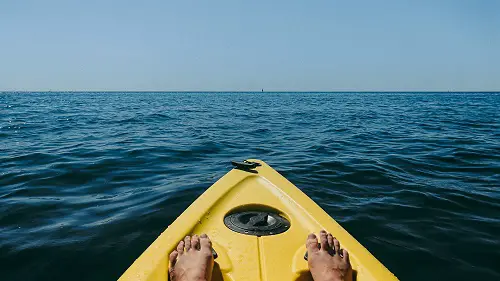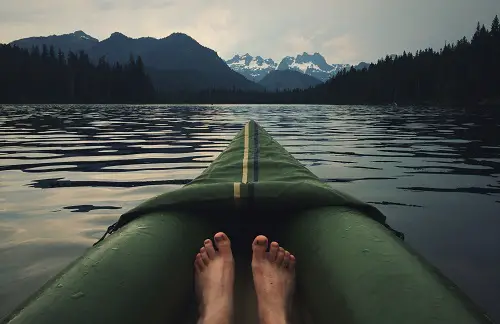Paddling sports are fun, relaxing, and great to exercise. But you will need some equipment to make your kayaking adventures as enjoyable and safe as possible. If you’re just getting started, it’s normal to have questions about what you should wear on the water.
Apart from the life jacket, helmet, and bathing suit, you might also need something to protect your feet. Most beginners don’t have kayak footwear to put on, and many paddlers wonder if it’s necessary. I had the same question not a long time ago, so here’s what I’ve found on the subject!
Can I Go Kayaking Barefoot?
You can kayak barefoot, but it’s generally not recommended. Although it can be more convenient and comfortable to paddle without footwear, it’s not always safe. Kayaking barefoot might expose your feet to multiple dangers, including sharp rocks and bacteria. That’s why it’s often better to wear water shoes.

I used to kayak barefoot, so it’s definitely possible. Now, I wear my water booties most of the time while paddling to keep my feet safe.
My experience with and without footwear allowed me to understand the benefits and drawbacks of each option. In this article, I will share everything you need to decide if you should or not go kayaking barefoot!
Is It Safe To Kayak Barefoot?
Without anything on your feet, you’re more likely to hurt or injure yourself while kayaking. Thus, staying barefoot isn’t the safest option for this sport. Wearing water shoes or sandals will give you additional protection.
Risks Of Kayaking Barefoot!
By setting aside footwear, you make this activity slightly more dangerous. There are two main hazards you should be aware of before kayaking barefoot. Understanding what the risks are will help you avoid them.
Injuries.
My principal concern about kayaking barefoot is walking on something that can hurt you. Even if your feet aren’t at risk in the boat, you still have to launch and get out of it. Whether you have the misfortune to step on dangerous rocks, corals, or debris, there’s a risk of injury.
Your feet also don’t offer as much traction as water shoe rubber soles. That’s why slippery environments aren’t safe for barefoot kayaking. Falling on wet rocks can be extremely painful and cause serious injuries.
Wild animals can also be potentially dangerous for you in the water, especially if you’re barefoot. As long as you don’t make them feel threatened, they shouldn’t be aggressive. But you will be happy to wear protective footgear if you accidentally step on an alligator snapping turtle.
Diseases.
Another potential danger to kayak without footwear is contact with harmful organisms found in the water or on the beach. By staying barefoot, you expose your skin to bacteria and viruses. Which means you’re more likely to develop water-borne diseases.
In general, it’s only a problem if you plan to paddle in a tropical area. But always inform yourself about the environment before kayaking there barefoot. You can also invest in water shoes to avoid diseases as much as possible.
I found this second type of risk in an article from the Water Kayaking blog. You can read it if you want more information.
Benefits Of Kakaying Barefoot!
Wearing nothing on your feet while paddling isn’t all negative; it also has some advantages. Although it’s not the best option for protection, I still enjoy barefoot kayaking from time to time for a couple of good reasons. Here’s why you might want to consider leaving footwear at home next time you head out in the water.
Comfort.
Like many outdoor enthusiasts, I prefer wearing nothing on my feet when it’s not necessary. It simply feels better for me to stay barefoot. That’s why I would generally choose to kayak without footwear if it was only about comfort.
Convenience.
There’s already quite a bit of gear to bring in a kayaking trip. If you can remove water shoes from the list, do yourself this favor. It means you won’t have to carry and put them on every time you head out in the water.
Control.
It might be just me, but I also think that kayaking barefoot offers slightly more maneuverability over the boat. Water boots or sandals can restrict my movements a little bit. Even if the difference is minor, my overall experience is better when I’m barefoot.
Barefoot Kayaking | Pros & Cons.
Pros.
- Comfortable.
- Convenient.
- Better Experience.
Cons.
- Riskier.
- Not Warm.
When It’s OK To Kayak Barefoot?
There are many factors to consider to figure out if you should or not have footwear while kayaking. Sometimes it’s not a bad idea to stay barefoot. As long as you know the risks and make sure the conditions are appropriate, there should be no problem.
It can be OK to kayak with nothing on your feet if you plan to go in a safe environment. For example, a beach free from corals and harmful bacteria would be ideal in this case. On the other hand, paddling barefoot down a river where you might have to step on sharp or wet rocks is dangerous.
For your safety, I always recommend wearing kayak footwear. My experience walking barefoot in rapids or other hazardous environments wasn’t always positive. I’ve often hurt and injured myself, so you don’t have to.
Things To Consider Before Kayaking Without Footwear!
Now that you know when it’s appropriate to paddle barefoot, it’s time for more details. There are several elements you should analyze before heading out into the water. Here are some conditions you need to keep in mind.

Temperature.
If you’re barefoot and the weather is cold, it won’t be fun nor safe to kayak. In this case, water shoes are the way to go. Made from neoprene, they act like a wetsuit to keep your feet warm.
During hot summer days, leaving them aside might be an excellent idea. Wearing something warm and wet isn’t appropriate. Thus, you should adjust your footwear according to the temperature.
Your Kayak Design.
Sometimes, it’s not comfortable to wear shoes because of the boat you have. For example, I’ve got a whitewater kayak so tight that I can barely fit in it. Putting my water booties on in this kayak isn’t agreeable, so I rarely do it.
Environment.
The spot in which you want to kayak can also influence whether you should wear something on your feet or not. In general, it’s more appropriate to paddle barefoot in the ocean. With the beach, you can launch in the water comfortably and safely.
In a river, there are almost inevitably wet and sharp rocks you might step on. You will also probably need to transport your kayak and walk on dangerous terrains. So the risk of getting hurt is usually higher in this type of environment.
What About Porting A Kayak Barefoot?
Once in the boat, your feet are protected by the cockpit. So footwear isn’t always necessary while paddling. However, you might have to carry your kayak before launching it in the water.
If it’s your case, having something on your feet preferable to avoid problems during transportation. Walking barefoot isn’t fun nor safe on hot pavement, gravel or riverbank.
You can also wear flip flops when carrying your kayak and take them off to feel more comfortable while paddling. On a beach, it’s easy to let your footwear in the sand with the rest of your stuff. But when going down a river, you have to pack everything in the kayak or keep your water shoes on during the whole trip.
Best Footwear For Paddling Sports!
Now that you know it’s generally not a good idea to kayak barefoot, it’s time to explore other alternatives. Protecting and keeping your feet warm is essential to make your adventures as enjoyable as possible. So here are different types of kayaking footwear to consider.
Flip Flops/Sandals.
With the sole and straps, this type of footwear will only protect your feet partially. But it’s still better than nothing. Although it’s not the best option, flip flops and sandals can be comfortable and convenient for kayaking.
Read More → Should You Kayak With Flip Flops?
Water Shoes.
They offer safety, traction, and support, so it’s ideal for paddling sports. Usually made from neoprene, it can also keep your feet warm in cold water. Protective, comfortable, and versatile, every kayaker should have water shoes.
Learn more about the best whitewater kayaking shoes!
When Should You Kayak With Something On Your Feet?
Overall, it’s not a good idea to go kayaking barefoot somewhere you can potentially injure your feet. Even in a safe environment, it’s hard to keep them out of danger without any footwear. That’s why you should nearly always have something on to protect them.
Do yourself the favor of investing in water shoes or at least flip-flops to prevent you from suffering unnecessarily. Having the proper equipment will make your paddling adventures much more fun and less risky.
Last Thoughts About Kayaking Barefoot!
There’s nothing that restricts you from paddling without footwear. I have done it, other people do it, and some of them will continue to do it. Nonetheless, it doesn’t mean you should always kayak barefoot either.

With all the dangers on the ground and in the water, I highly recommend having appropriate footwear for this activity. Otherwise, you might seriously hurt or injure yourself. The benefits of kayaking barefoot are rarely worth the risks it includes.
I hope my article has helped you understand why you should wear something on your feet during your paddling trips. Now it’s time to find protective gear and finally head out in the water.
